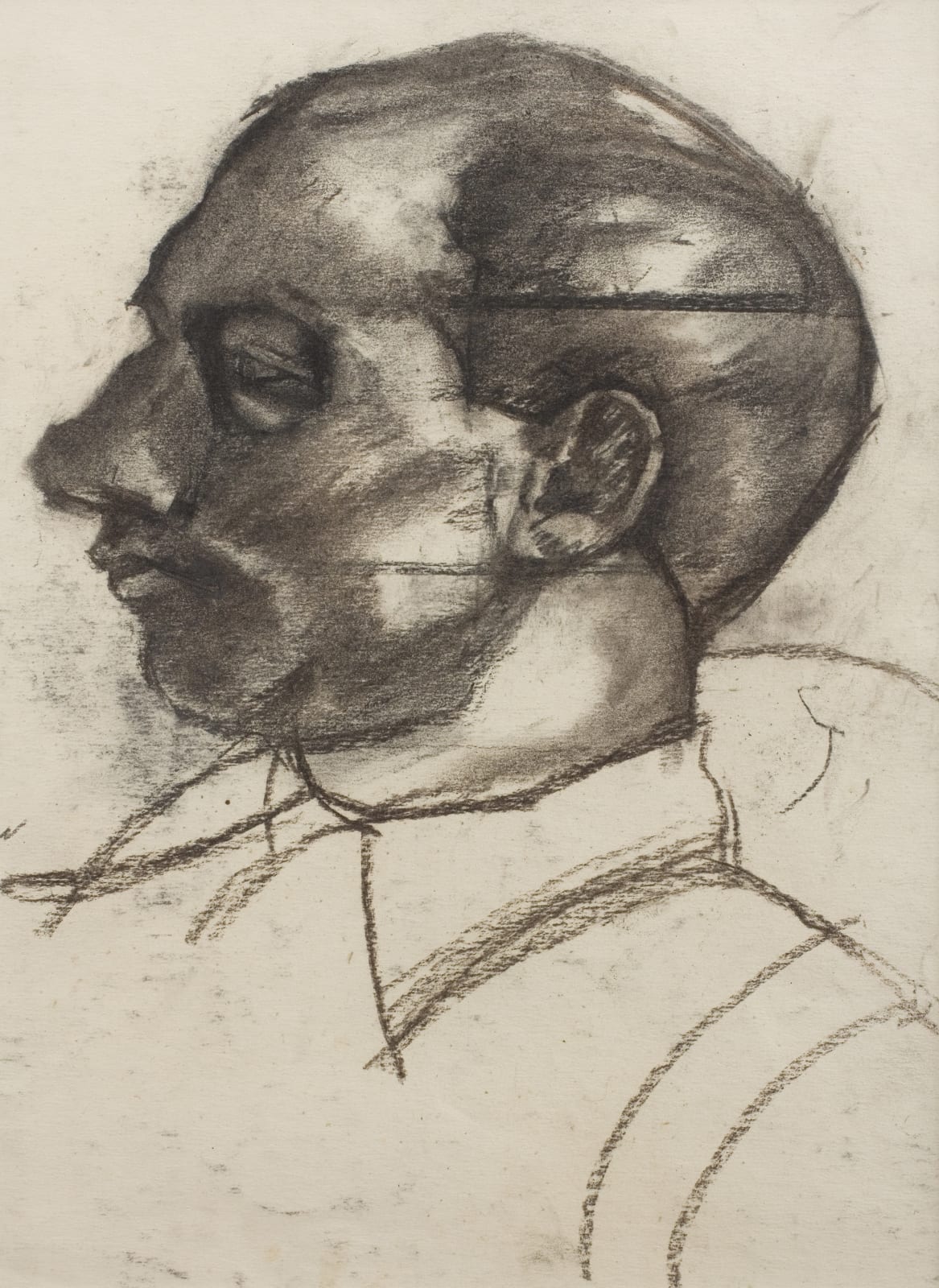David Bomberg
Self-Portrait, 1920 c.
Charcoal
38 x 26.5 cm
15 x 10 3/8 in
15 x 10 3/8 in
Ruth Borchard Collection
Before and during the First World War, Bomberg worked in an abstract manner. In the autumn of 1919, Frank Rutter displayed at his new Adelphi Gallery more than one hundred...
Before and during the First World War, Bomberg worked in an abstract manner. In the
autumn of 1919, Frank Rutter displayed at his new Adelphi Gallery more than one hundred
drawings of aggressively geometricised groups of figures recently produced by Bomberg.
They remained rooted in his most radical pre-war painting and were commended by
Herbert Read for their ‘high standard of formal beauty’. Read went on to conclude that
‘the fact that Mr Bomberg has ideas is his most remarkable peculiarity’ and that the
bold twenty-eight-year-old ‘is possibly a great artist’.1 Favourable comment from a wellinformed
voice in a critical climate so hostile to abstract work ought to have encouraged
the continuation of Bomberg’s abstract idiom. Instead, he moved in the opposite
direction.
The Self-Portrait presented here was produced soon after the Adelphi exhibition. It is
closely related to two oils of a similar size produced at approximately the same time,
and which display what Richard Cork has described as the ‘jutting belligerence and
determination which characterised the young Bomberg’. Significantly, the
present work is realised without the stylistic radicalism of his earlier years. The artist’s
features are delicately shaded in charcoal. His relative maturity is indicated by a balding
head and neat collar which would have been anathema to the shabby swagger he
fashioned during his time at the Slade. Bomberg sustains the observational diligence
found in his earlier self-portraiture, but here a direct gaze is replaced by a profile,
detaching us from the sitter’s interiority. Instead, we are directed to his sense of purpose,
progress, and vision.
It is tempting to read Bomberg as looking towards the formative time he would soon
spend in Jerusalem. Although he would have to wait until 1923 for that decisive shift in
his career, already this self-portrait offers a glimpse of the adamantine focus and integrity
he would bring to his subsequent practice. The same studied calm occupies him here as
he would apply in broad brush swathes over the Palestinian landscape, while remnant
measuring lines that seem to incise his cranium and jaw pre-empt the impassioned
gestural calculation of mass and form he would develop in Toledo.
autumn of 1919, Frank Rutter displayed at his new Adelphi Gallery more than one hundred
drawings of aggressively geometricised groups of figures recently produced by Bomberg.
They remained rooted in his most radical pre-war painting and were commended by
Herbert Read for their ‘high standard of formal beauty’. Read went on to conclude that
‘the fact that Mr Bomberg has ideas is his most remarkable peculiarity’ and that the
bold twenty-eight-year-old ‘is possibly a great artist’.1 Favourable comment from a wellinformed
voice in a critical climate so hostile to abstract work ought to have encouraged
the continuation of Bomberg’s abstract idiom. Instead, he moved in the opposite
direction.
The Self-Portrait presented here was produced soon after the Adelphi exhibition. It is
closely related to two oils of a similar size produced at approximately the same time,
and which display what Richard Cork has described as the ‘jutting belligerence and
determination which characterised the young Bomberg’. Significantly, the
present work is realised without the stylistic radicalism of his earlier years. The artist’s
features are delicately shaded in charcoal. His relative maturity is indicated by a balding
head and neat collar which would have been anathema to the shabby swagger he
fashioned during his time at the Slade. Bomberg sustains the observational diligence
found in his earlier self-portraiture, but here a direct gaze is replaced by a profile,
detaching us from the sitter’s interiority. Instead, we are directed to his sense of purpose,
progress, and vision.
It is tempting to read Bomberg as looking towards the formative time he would soon
spend in Jerusalem. Although he would have to wait until 1923 for that decisive shift in
his career, already this self-portrait offers a glimpse of the adamantine focus and integrity
he would bring to his subsequent practice. The same studied calm occupies him here as
he would apply in broad brush swathes over the Palestinian landscape, while remnant
measuring lines that seem to incise his cranium and jaw pre-empt the impassioned
gestural calculation of mass and form he would develop in Toledo.
Provenance
The Estate of the Artist
Fischer Fine Art, London
Private Collection, U.S.A.
Ruth Borchard Self-Portrait Collection, UK
Exhibitions
1985, London, Fischer Fine Art, David Bomberg, 1890-1957: A Tribute to Lilian Bomberg, 14th March - 12th April, cat. no.412016, London, Piano Nobile, The Ruth Borchard Collection: The Next Genaration, 7th June - 24th September
Artists Self-Portraits, The Lightbox Gallery Working, 25 March - 25 June 2017,
Self: Ruth Borchard Collection, Manx Museum Isle of Mann, October 2020 - March 2021
Artists Self-Portraits, The Lightbox Gallery Working, 25 March - 25 June 2017,
Self: Ruth Borchard Collection, Manx Museum Isle of Mann, October 2020 - March 2021
Subscribe for Updates and Events
* denotes required fields
We will process the personal data you have supplied to communicate with you in accordance with our Privacy Policy. You can unsubscribe or change your preferences at any time by clicking the link in our emails.
